The moment of delivering the frame to a customer is very important, as it on that moment that the customer decides whether to remain as our client or not.
Packaging
The customer's frame has already been completed. It is from this point that this
article begins.
First there is the packaging. Is it better to wrap the framed pictures as soon
as they are ready or wait until the client has seen them? I believe it is better
to wrap them as soon as they are finished in order to avoid the possibility of
them getting ruined. However, I have seen a framer hang unwrapped finished
framed pictures just like clothes in a closet. It could be an alternative.
What paper should they be wrapped in? Normal package paper will do. It does not
have to be very thick paper. Sixty-gram weight per square meter (slightly more
than a sq. yd) is sufficient. The main purpose of the paper is to protect the
picture from possible scratches from other pictures or objects. Paper is sold
both in sheets and rolls. It is probably more sensible to use a roll and unroll
only the amount of paper that is needed. A roll-holder could be placed under the
workbench or hung on a wall within easy reach.
It is better not to wrap more that two frames in the same package to avoid them
rubbing against each other. Don't use more than 3 cm. (1") of adhesive tape to
stick the paper together. This will permit you to open the package in front of
the customer without risk of ripping the paper. You will also save on adhesive
tape.
It is advisable to draw a small arrow on the package indicating the top of the
picture. This is useful when standing-up the package so that the hangers are on
top, otherwise the weight might deform them. It also serves to open the package
in the right direction without having to turn it upside down when showing the
picture to the customer.
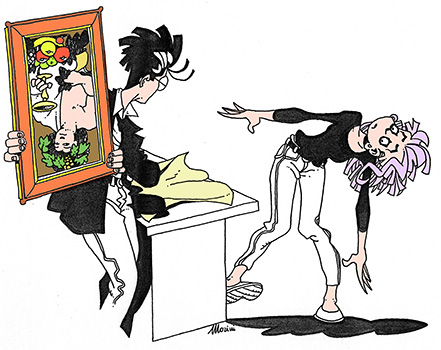
Storing the finished pictures
After wrapping, the package can be stored on a shelf until the customer comes to
pick it up. The customer's name should be written on the outside of the package
to facilitate finding it. If there are quite a few packages, a more elaborate
retrieval system will be necessary. I suggest a procedure that I have been using
for some time. The packages are stacked in a shelf that has many compartments.
Note that work in progress can also be placed on this same shelf. The
compartments of the shelf are numbered progressively. A copy of each receipt is
inserted in a receipt file with the customers' names in alphabetical order. The
compartment identification number where the customer's picture has been placed
is noted on the receipt. When the customer comes to pick up his picture, we
firstly look for the receipt in the receipt file under the client's name. Then,
looking at the previously noted compartment number on the receipt, the customer's
picture will be found in the indicated compartment. I can assure you that this
system works quite well. The package is then brought onto the front counter and
opened in front of the customer.
In front of the customer
Do not hand over the package without first opening it and showing the picture
to the customer. If you follow the previously mentioned suggestions, opening the
package will be very quick. Just lift up the 3 cm. (1") adhesive tape without
ruining the paper. By opening both sides of the package paper, the picture will
be presented to the customer in the correct position, with the top facing
towards us and the bottom towards the customer.
At the exact moment that the package is opened you may note that the customer
will generally have a satisfied expression. The framed picture is always a
delightful surprise for the customer, who does not expect that his picture can
become so precious as to seem even more beautiful than what it actually is. This
is one of the most gratifying moments for the framer. During this phase it is
opportune to make a few comments such as: "It came out really nice, didn't it?"
or "It's just the right frame for this picture," thereby also complimenting the
customer for his choice. Other phrases in this circumstance might be: "A frame
makes all the difference for any picture," and "With this frame the picture
stands out more," or "We had a bit of trouble finding the right frame, but in
the end we found one that's just right," or more generically "I am glad that you
like it." You could finally note that the colour of the edging or the tonality
of the frame is exactly the same as that in parts of the picture, etc.
These are the moments in which a new customer is firmly convinced of having
found the right framer.

Complaints
Unfortunately things do not always go well. Sometimes the customer doesn't seem
so enthusiastic. Instead of bursting with joy, he examines the picture with a
critical eye.

It's the first sign of a battle. After a few moments of hesitation he begins with "I thought I had chosen another frame," or "The mountboard is not the same as the sample I saw." Worse still is if he stares at a corner of the frame where there is a 2 mm. crack, or if he finds some lint inside the picture. How to act in such a circumstance? First of all, don't put the customer in a position to notice any defects. But don't misunderstand me. I'm not saying to dupe the customer, only don't make defects so evident. Irrelevant defects can be easily "hidden" without having to suffer from a bad conscience. If, for example, there's a defect on the top of the frame, nobody will ever notice it, since once the picture is hung it will never be seen. Therefore, it is better in this case that the customer doesn't know about it.
Some helpful hints for making defects less evident are:
|
• |
|
Use only diffused lighting on pictures. Avoid showing the picture under a direct light as all the defects would show up. We can appease our conscience considering that the picture will probably not be hung under a direct light in the customer's house anyway. |
|
• |
|
Don't lift the picture out from the wrapping paper. This way you can quickly close it as soon as the client has given it a cursory glance. All of us have opened and closed a package in the record time of 2 seconds flat from time to time. But if you seem too hurried, it will look suspicious which is not at all advisable. |
|
• |
|
If you have noticed a defect on the side of the frame, lift the frame up to show the picture better, but hold it in such a way as to cover the defect with your hand. Distract the customer by showing him the other pictures, putting the defected frame under the others.
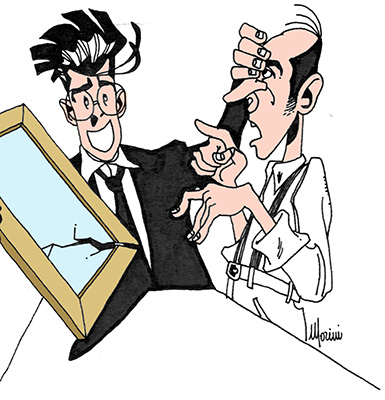 |
How to act during a complaint?
Naturally depends from case to case and from client to client. Let's analyse the
various cases.
The customer complains because he sustains to have chosen a different frame or
mountboard, etc. It's difficult to say if he is right or wrong. Sometimes the
customer is half right. Probably the samples that we have in the store do not
correspond exactly to the mouldings we have in the workshop. Or perhaps we
showed a model similar to an unavailable one, hoping that the customer wouldn't
notice. Even if we are sure of being right, it is not always opportune to tell
the customer he is mistaken. Because even if we can prove that we are right, we
will have lost the customer anyway. If possible, try to fix the defect then and
there to the customer's satisfaction. For example, if there's a piece of lint in
the picture, it is better to open the picture up and take the lint out while the
customer is waiting, saying, "Don't worry, it can be fixed in a few minutes." Be
kind and sincerely tell the client you're sorry. Perhaps the client, touched by
so much kindness, will pay for the work anyway and come back to pick it up later
asking you just to make sure you do the work well. If the frame is defective try
asking the client if he will keep it anyway, at a generous discount. It is often
more convenient for the framer to give a discount instead of remaking a complete
frame. This agreement will probably please the customer just the same. This won't
always work though, especially if the customer plans to give the framed picture
as a present. If the frame or mountboard is not the same as the ordered one, we
can try stating: "You're right, the frame is not exactly the same", but I'd be
tempted to say "I think it fits the picture better. Do you want to take it home
and see what your family thinks? If you are not completely satisfied, I assure
you that I will redo the frame (or mountboard)." Substantiate this by putting it
in writing on the receipt. In most cases the customer will keep the frame.
Complaints by the customer are always a nuisance, but you have to admit it can
be a good detector as to how the company is being run, especially if your
collaborators are doing the work.
Gift wrapping paper
Sometimes customers ask if we have gift wrapping paper. It would be better to
always have some available. Of course, wrapping paper is an expense for us, so
you have to get the customer to pay for it somehow. In addition, there's the
work involved in preparing the package. I suggest that a sign be displayed,
especially around Christmas time, that informs the customers that their picture
can be gift wrapped for such and such amount. This will both inform the customer
of the gift wrapping possibility and at the same time avoid the embarrassment of
having to ask for an additional cost for the service. An example is illustrated
here to our right.
Gift wrapping available. Price per package (including ribbon and bow) £1.00
This service can be extended to other articles that a client wants wrapped that
have not necessarily been bought in the frame shop .
Gift wrapping paper is sold in rolls or in loose sheets. Stationary shops are
usually well supplied. If, however, you prefer to buy a whole pack (usually 100
sheets) you'd pay less by buying from a wholesaler. The same holds true for the
ribbon and bows to be applied on the package. The ideal solution is to use a
roll of wrapping paper which can wrap different size packages in desired amounts
hence not wasting paper.
Small gifts
It might be nice to enclose a small gift inside the package. For example, if you
have some prints you don't know how to get rid of, you could give them away, one
per customer. Maybe the customer will want it framed.
Other things you could include are publicity brochures, information on new
articles, invitations to painting exhibitions, or even small pictures or frames.
“I've lost my receipt”
Strange or embarrassing situations can take place when the customer comes to
pick up his framed pictures. Let's consider some of these situations.
The client says he cannot find the receipt given to him when he ordered the
picture. If you know the customer, no problem. You can find the picture under
his name.
Sometimes there's confusion with the surname, especially between married couples,
when the wife uses her maiden name. If you can't find the pictures under a
certain name, ask if another name might have been used. If the pictures are
still not found after a thorough search you might ask the customer if they are
certain of having brought the pictures to your store to be framed. Sometimes the
person in charge of collecting the pictures goes to the wrong framer. You
shouldn't get upset if this happens. You can resolve the situation by saying
something like, "It doesn't matter. At least we got to know each other."
Between husband and wife other problems may arise. I once had a couple who got
divorced with separation of possessions after ordering a frame. It took several
years to find out who was allotted the picture.
“Is there a hanger?”
This is a question customers sometimes ask. "Yes, there is a hanger", you answer
politely as if it were a concession framers rarely make. If there are two
hangers it is well to advise the customer patiently explaining why. "We always
put two hangers on large pictures in order to make them more stable and to avoid
swinging. In addition, the top part of the picture won't warp with the weight."
You can add that plate hangers were used to allow the customer more precision
when hammering the two nails. You should always ask the customer if he has any
nails to hang the frame with. The customer usually doesn't remember. Show him
the boxes of nails displayed on the counter and ask, "Would you like to buy a
box?" The price should labelled on the boxes. That way you will avoid the
awkwardness of having to say that the boxes are for sale and not free.
Payment
If the price was agreed upon during ordering, there shouldn't be any particular
problems at delivery. There are some clients however, who won't give up and try
to get a last minute discount. Unless it's a minimal amount, you should not give
in. You must be kind, but firm. Recommended phrases might be: "We settled the
price when the frame was ordered and this was deliberately done to avoid any
arguments now." Or, "I always prefer to settle the price when the frame is
ordered so I won't have any surprises later."
If the price was not settled beforehand then the framer might indeed find
himself in trouble. This is the reason why it is better to establish the price
before doing the work, and not after.
Picture transportation
It is worthwhile to help the customer lift the packages and load them into his
car, especially if they are large.
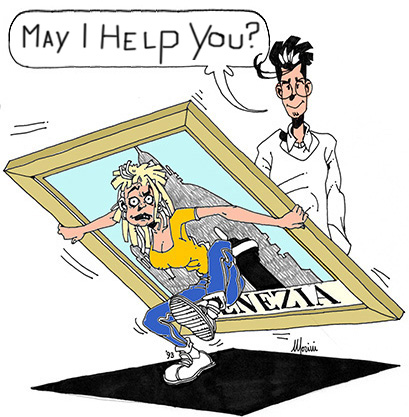
This could be done by the sales clerk or by workshop personnel. It is often necessary to hold the door open when the customer sheets as his hands are full of pictures. These are small details that the client appreciates. But above all, doing so helps avoid other problems.

I'm referring to damages the customer can inflict to the frames. I am often horrified at how customers load pictures. Hardly anybody realises that frames are delicate and can easily get ruined. If the pictures are very big, it is better to give the customer some suggestions as to how to transport them, especially if you notice he is not very experienced. If the client persists in wanting to load them his way, you might, half jokingly and half threateningly say, "These pictures were in one piece when they left the shop, so it won't be my fault if you bring them back with the glass cracked."


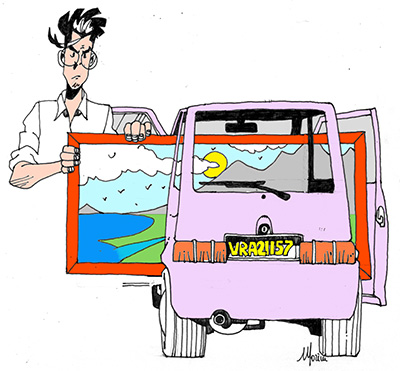
What should you do if the customer asks that the pictures be delivered to his house? It depends on your organisation. If you have a small van or a car that will hold big pictures, then it might be worthwhile to accept to do home deliveries. Obviously, it is a service that must be paid for. A sign like the one here displayed has two purposes: it informs the clients of this possibility, and lets them know that the service is not free.
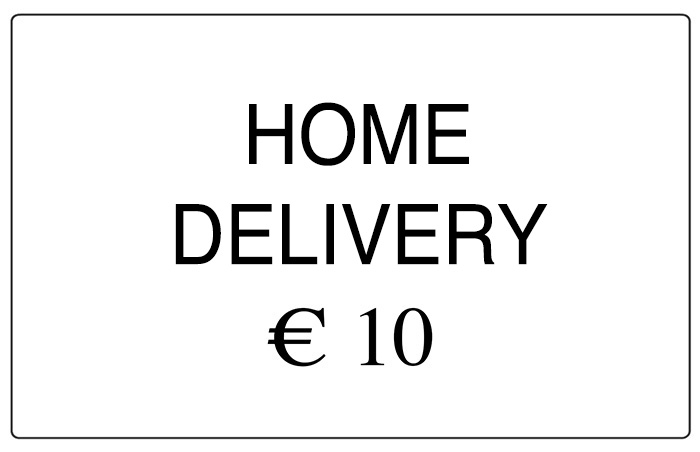
Another service that might be offered is picture hanging at the customer's
house. Some clients don't have the time or don't want to be bothered with
hanging pictures. Others simply aren't able to do so, because the picture is too
big, or they don't have a ladder, tape measure, hammer etc. A sign in this case,
would also advise the customers of this service. These are additional services
that increase profits and are appreciated by the customers.
Home delivery can be an occasion to give some advice on the way the pictures
should be hung, how to arrange them, etc. The framer might make some comments
like: "A long horizontal picture would look great on this wall," or "In this
hall I would hang a series of antique prints," or even, "What a nice picture,
too bad the frame is ruined," or again, "There are woodworms in that frame. You'd
better change it before they spread to other frames."